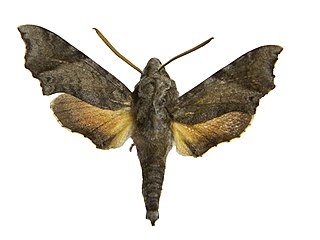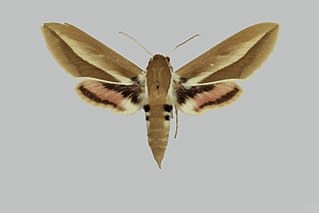
Hyles euphorbiae, the spurge hawk-moth, is a European moth of the family Sphingidae. It has been found in Pontresina, Switzerland. This hawk moth is used as an agent of biological pest control against the noxious weed leafy spurge, but usually only in conjunction with other agents. The larvae consume the leaves and bracts of the plant. The species was first described by Carl Linnaeus in his 1758 10th edition of Systema Naturae.

Hyles gallii, the bedstraw hawk-moth or galium sphinx, is a moth of the family Sphingidae. The species was first described by S. A. von Rottemburg in 1775.

Hyles hippophaes, the seathorn hawk-moth, is a species of moth in the family Sphingidae. The species was first described by Eugenius Johann Christoph Esper in 1789.

Hyles livornica, the striped hawk-moth, is a moth of the family Sphingidae.

Hyles tithymali, the Barbary spurge hawk-moth, is a species of moth in the family Sphingidae first described by Jean Baptiste Boisduval in 1834. Genomic analysis places the entire species as a subspecies of Hyles euphorbiae. It is found in North Africa, the Canary Islands, Madeira, some islands in the Mediterranean Sea and in the mountains in Yemen.

Hippotion geryon is a moth of the family Sphingidae. It is known from Madagascar and the Comoro Islands.

Hyles dahlii is a moth of the family Sphingidae first described by Carl Geyer in 1828.

Hyles perkinsi, or Perkin's sphinx, is a species of moth of the family Sphingidae. It was described by Otto Herman Swezey in 1920. It is endemic to the Hawaiian islands of Oahu and Molokai.

Hyles sammuti is a moth of the family Sphingidae. Kitching and Cadiou (2000) treat it as a valid species, while Pittaway treats it as a subspecies of Hyles tithymali, seeing the larvae are very similar to Hyles tithymali mauretanica. Based on studies of the mitochondrial DNA, Hyles sammuti probably hybridises with Hyles euphorbiae. It is known from Malta, but there are closely related populations found on Sicily and southern Italy, which might prove to be the same species.

Pantophaea favillacea is a moth of the family Sphingidae. It is known from savanna and bush from eastern Kenya to Tanzania, Zambia, Angola, Zimbabwe and Mozambique.

Temnora leighi is a moth of the family Sphingidae. It is known from the Comoro Islands.

Temnora avinoffi is a moth of the family Sphingidae. It is known from Nigeria to Cameroon and Gabon.

Temnora wollastoni is a moth of the family Sphingidae. It is found from Liberia, east to the Central African Republic and then south to the Democratic Republic of the Congo, the Republic of the Congo and Gabon.

Temnora scheveni is a moth of the family Sphingidae. It is known from Tanzania, Uganda and Rwanda.

Temnora pylades is a moth of the family Sphingidae. It is known from Uganda, Kenya, Tanzania and Malawi.

Hypaedalea lobipennis is a moth of the family Sphingidae. It is known from West Africa, including Cameroon and Uganda.

Hyles centralasiae, the eastern foxtail-lily hawkmoth, is a moth of the family Sphingidae. The species was first described by Otto Staudinger in 1887. It is found from eastern Turkey and Armenia east across northern Iraq, northern Iran, southern Turkmenistan, the mountainous areas of eastern Uzbekistan and southern Kazakhstan to Tajikistan, Kyrgyzstan, Afghanistan and northern Xinjiang in China.

Hyles chamyla, the dogbane hawkmoth, is a moth of the family Sphingidae. It is only known from Xinjiang in China.

Hyles robertsi, the spurge hawkmoth, is a moth of the family Sphingidae. The species was first described by Arthur Gardiner Butler in 1880. It is known from Iran, the Kopet Dag Mountains of Turkmenistan, eastward to central and eastern Afghanistan, Kashmir and the Pamirs. It is also known from western Pakistan. Some authors consider it to be a subspecies of Hyles euphorbiae.

Centroctena rutherfordi is a moth of the family Sphingidaefirst described by Herbert Druce in 1882. It is known from forests from Sierra Leone to Uganda and western Kenya. It is also found in the Usambara Mountains of north-eastern Tanzania.




















